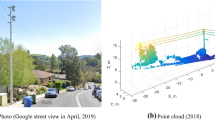Abstract
The dangerous, overgrown vegetation/trees under high voltage transmission lines right-of-ways (ROWs) have caused severe blackouts/flashovers due to interference with power lines which leads to short circuiting among the conductors. Therefore, these dangerous encroachments are monitored periodically along the electrical distribution networks ROWs through visual inspection, or by airborne system. Each of these methods has its own attributes and limitations and have proved to be costly, time consuming and not much accurate. In these circumstances, it is necessary for the electrical utilities to review their vegetation management practices so as to avoid incidents of unintended encroachments. In tropical countries, overgrown vegetation is a common cause for power line failure. This paper proposes an innovative concept of utilizing a single camera for monitoring dangerous vegetation (trees, shrubs and plants, etc.) under transmission lines ROWs. The main focus is on using an imaging device (camera) integrated on each transmission pole to automate inspection for the vegetation encroachments endangering the transmission lines. These cameras are envisioned to be connected wirelessly to each other, forming a series of wireless camera networks that can be monitored remotely. A single camera mounted on power poles acquires images and sends them wirelessly to the base station. At base station, algorithm (software) trained by image processing and pattern recognition techniques is used to identify (height, depth, and width of encroached vegetation, etc.) excess vegetation encroachments within and outside ROWs. The performance evaluation of a real time developed test-bed scenario proves the feasibilities of integrating the method for transmission line maintenance.


























Similar content being viewed by others
References
Andersson G, Donalek P, Farmer R, Hatziargyriou N, Kamwa I, Kundur P, Martins N, Paserba J, Pourbeik P, Sanchez-Gasca J, Schulz R, Stankovi A, Taylor C, Vittal V (2005) Causes of the 2003 major grid blackouts in North America and Europe, and recommended means to improve system dynamic performance. IEEE Trans Power Syst 20:1922–1928
J. Ahmad, Aamir S. Malik, L. Xia (2011) “Effective techniques for vegetation monitoring of transmission lines right-of-ways,” IEEE International Conference on Imaging Systems and Techniques, Penang, Malaysia, pp. 17–18 34–38
Ahmad J, Malik AS, Xia L, Ashikin N (2013) Vegetation encroachment monitoring for transmission lines right-of-ways: a survey. Electr Power Syst Res 95:339–352
Duller A, Whitworth C, Jones DI, Earp GK (2001) Aerial video inspection of overhead power lines. IET Power Eng J 15(1):25–32
Jones DI, Earp GK (2001) Camera sightline pointing requirements for aerial inspection of overhead power lines. Electr Power Syst Res 57:73–82
Mclaughlin RA (2006) Extracting transmission lines from airborne LIDAR data. IEEE Geo-Sci Remote Sensing Lett (GSRS) 3:222–226
Sun C, Jones R, Talbot H, Wu X, Cheong K, Beare R, Buckley M, Berman M (2006) Measuring the distance of vegetation from power lines using stereo vision. ISPRS J Photogramm Remote Sens 60:269–283
Mills SJ, Castro MPG, Li Z, Cai J, Member S, Hayward R, Mejias L, Walker RA (2010) Evaluation of aerial remote sensing techniques for vegetation management in power-line corridors. IEEE Trans Geo-Sci Remote Sens (TGSRS) 48:3379–3390
Akyildiz IF, Melodia T, Chowdury KR (2007) “Wireless multimedia sensor networks: a survey.” IEEE Wireless Comm 32–39
Yang Y, Lambert F, Divan D (2007) “A survey on technologies for implementing sensor networks for power delivery systems.” IEEE Power Eng Soc General Meeting
Erol-Kantarci M, Mouftah HT (2011) “Wireless multimedia sensor and actor networks for the next-generation power grid.” Ad Hoc Networks 9:542–511
Hirakawa AR, Martucci M, Vilhena CG, Amancio SM, Jose CV (2010) Lemos,“Wireless image transmission in electric power hostile environment”, IEEE 35th Conference on Local Computer Networks, Denver, USA, pp.760–763, 10–14
Corke P, and Wark T (2007) “Long-duration solar-powered wireless sensor networks,” Proceedings of the 4th Workshop on Embedded Networked Sensors Systems, pp. 33–37
Kurihata H, Takahashi T, Ide I, Mekada Y, Murase H, Tamatsu Y, Miyahara T (2005) “Rainy weather recognition from in-vehicle camera images for driver assistance,” IEEE Proceedings Intelligent Vehicles Symposium, pp. 6–8, 205–210
Dong N, Jia Z, Shao J, Li Z, Liu F, Zhao J, Peng PY (2011) Adaptive object detection and visibility improvement in foggy image. J Multimed 6:14–21
Hui Liu D, Man Lam K, Sun Shen L (2005) Illumination invariant face recognition. Pattern Recogn 38:1705–1716
Karhunen J (1998) Principal component neural networks-theory and applications. Pattern Anal Appl 1:74–75
(2002) IEEE, National Electrical Safety Code. Piscataway, NJ: IEEE, (ANSI C2-2002)
Tilawat J, Theera-umpon N, Member S (2010) Automatic detection of electricity pylons in aerial video sequences. Int Conf Electron Inf Eng 1:342–346
Li Z, Liu Y, Walker R, Hayward R, Zhang J (2010) Towards automatic power line detection for a UAV surveillance system using pulse coupled neural filter and an improved Hough transform. Mach Vis Appl 21:677–686
Guerreiro RFC, Aguiar PMQ, Member S (2011) “Connectivity-enforcing Hough transform for the robust extraction of line segments,” IEEE Transactions on Image Processing, pp. 1–26
Nieto M, Cuevas C, Salgado L, Garcia N (2011) Line segment detection using weighted mean shift procedures on a 2D slice sampling strategy. Pattern Anal Appl 14:149–163
Ting Chen Y, Rong Huang C, Ping Hung Y (2007) Efficient hierarchical method for background subtraction. Pattern Recogn 40:2706–2715
Berhad TN “http://www.tnb.com.my”
Yasir S (2011) ‘3D visual tracking using a single camera’, MSc thesis, Universiti Teknologi Petronas
Acknowledgments
This research work is supported by Electricity Trust Fund (MESITA), Akaun Amanah Industri Bekalan Elektrik (AAIBE) Grant, Ministry of Energy, Green Technology and Water Malaysia.
Author information
Authors and Affiliations
Corresponding author
Rights and permissions
About this article
Cite this article
Ahmad, J., Malik, A.S., Abdullah, M.F. et al. A novel method for vegetation encroachment monitoring of transmission lines using a single 2D camera. Pattern Anal Applic 18, 419–440 (2015). https://doi.org/10.1007/s10044-014-0391-9
Received:
Accepted:
Published:
Issue Date:
DOI: https://doi.org/10.1007/s10044-014-0391-9




